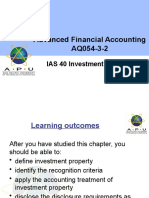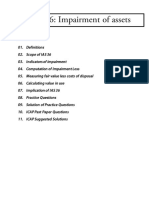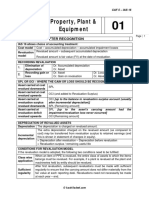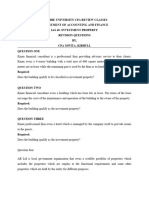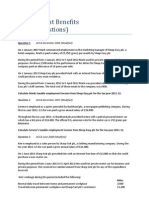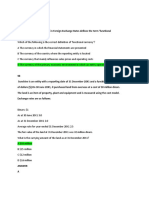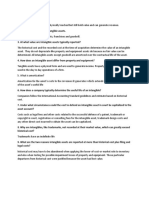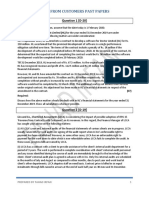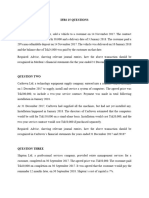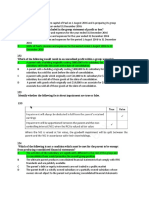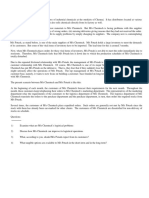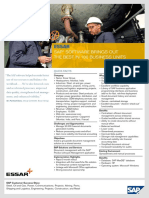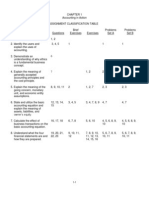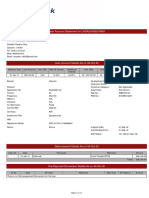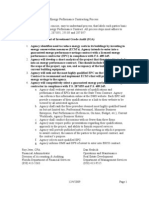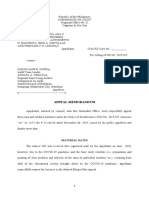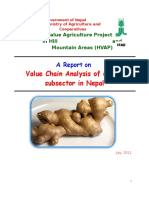IAS 38:
INTANGIBLE ASSETS
(Practice Questions)
F7 – FINANCIAL REPORTING
COMPILED BY: MURTAZA QUAID, ACA
�IAS 38: Intangible Assets Compiled by: Murtaza Quaid
IAS 38: INTANGIBLE ASSETS – PRACTICE QUESTIONS
Question 1.
Ateeq Limited acquires new technology that will significantly reduce its energy costs for manufacturing.
Costs incurred include:
Required: Calculate the cost that can be capitalised.
Question 2.
On 30 June 20X4, Habib Limited (HL) discovered that it had been manufacturing a product illegally since
this product happened to be a patented product for which it did not have the necessary rights. HL
immediately shut down its factory and hired a firm of lawyers to act on its behalf in the acquisition of
the necessary rights to manufacture this patented product.
Legal fees of Rs.50,000 were incurred during July 20X4.
The legal process was finalized on 31 July 20X4, HL was then required to pay Rs.800,000 to purchase the
rights, including Rs.80,000 as refundable taxes.
During the month of July 20X4, factory was shut-down:
Overhead costs of Rs.40,000 were incurred;
Significant market share was lost due to shut-down. HL’s total sales over August and September was
Rs.20,000 but its expenses were Rs.50,000, resulting in a loss of Rs.30,000.
To increase market share, HL spent an extra Rs.25,000 aggressively marketing its product. This
marketing campaign was successful, resulting in sales returning to profitable levels in October.
Required: Discuss which of the above costs relating to acquisition of patent can be capitalised.
Solution:
Purchase price: The purchase price should be capitalized, but this must exclude refundable taxes.
Rs. 720,000 (800,000 – 80,000).
Legal costs: This is a directly attributable cost. Directly attributable costs must be capitalized i.e. Rs.
50,000.
Overhead costs: This is not an incidental cost that is necessary to the acquisition of the rights (the
shut-down was only necessary because HL had been operating illegally).
IQ School of Finance 2
�IAS 38: Intangible Assets Compiled by: Murtaza Quaid
Operating loss: The operating loss incurred while demand for the product increased to its normal
level is an example of a cost that was incurred after the rights were acquired. Costs incurred after
the Intangible Asset is available for use will not be capitalized.
Advertising campaign: The extra advertising incurred in order to recover market share is an example
of a cost that was incurred after the rights were acquired. Furthermore, advertising costs are listed
in IAS 38 as one of the costs that should be expensed out.
Question 3.
Company Q has undertaken the development of a new product. Total costs to date have been Rs.
800,000. All of the conditions for recognising the development costs as an intangible asset have now
been met.
However, Rs. 200,000 of the Rs. 800,000 was spent before it became clear that the project was
technically feasible, could be resourced and the developed product would be saleable and profitable.
Required: Discuss the accounting treatment.
Solution: The Rs. 200,000 incurred before all of the conditions for recognising the development costs as
an intangible asset were met must be written off as a research costs (expense). The remaining Rs.
600,000 should be capitalised and recognised as an intangible asset (development costs).
Question 4.
Sino Care Limited (SCL) started a R&D project for developing new product on 1st January 20X1. The
following expenditure was incurred during 20X1. Year-end is 31 December 20X1.
Research phase (1 January to 31 March): Rs. 1 million per month
Development phase (1 April to 31 October): Rs. 1.5 million per month.
The project become technically feasible on 31 August 20X1 when initial patent was also submitted for
registration.
Required: Discuss the accounting treatment.
Solution:
Expenditure incurred in research phase from 1 January to 31 March of Rs. 3 million (i.e. Rs. 1 million x 3
months) shall be charged to profit or loss.
Expenditure incurred in development phase from 1 April to 31 August of Rs. 7.5 million (i.e. Rs. 1.5
million x 5 months) shall be charged to profit or loss since in this period the capitalisation criteria was
not met. Even after the criteria for capitalisation has been met subsequently, this expenditure shall not
be reinstated as an asset.
Expenditure incurred in development phase after capitalisation criteria has been met from 1 September
to 31 October of Rs. 3 million (i.e. Rs. 1.5 million x 2 months) shall be capitalised as intangible asset.
IQ School of Finance 3
�IAS 38: Intangible Assets Compiled by: Murtaza Quaid
Question 5.
Saqib Limited began researching and developing an intangible asset. The following is a summary of the
costs that the R&D Department incurred each year:
20X1: Rs.180,000
20X2: Rs.100,000
20X3: Rs.80,000
Additional information:
The costs listed above were incurred evenly throughout each year.
Included in the costs incurred in 20X1 are administrative costs of Rs. 60,000 that are not considered
to be directly attributed to the research and development process. The first two months of the year
were dedicated to research. Then development began from 1 March 20X1 but it was unable to
measure reliably the expenditure on development till 31 March 20X1.
Included in the costs incurred in 20X2 are administrative costs of Rs. 20,000 that are considered to
be directly attributed to the research and development process.
Included in the costs incurred in 20X3 are training costs of Rs. 30,000 that are considered to be
directly attributed to the research and development process as in preparation for the completion of
the development process, certain employees were trained on how to operate the asset.
Required: Prepare journal entries related to the costs incurred for each of the years ended 31 December
20X1 to 20X3 and briefly comment on accounting treatment. .
Question 6.
During 20X5 Henry has the following research and development projects in progress:
Project A was completed at the end of 20X4. Development expenditure brought forward at the
beginning of 20X5 was Rs. 412,500 on this project. Savings in production costs arising from this project
are first expected to arise in 20X5. In 20X5 savings are expected to be Rs. 100,000, followed by savings
of Rs. 300,000 in 20X6 and Rs. 200,000 in 20X7.
Project B commenced on 1 April 20X5. Costs incurred during the year were Rs. 56,000. In addition to
these costs a machine was purchased on 1 April 20X5 for Rs. 30,000 for use on the project. This machine
has a useful life of five years. At the end of 20X5 there were still some uncertainties surrounding the
completion of the project.
Project C had been started in 20X4. In 20X4 the costs relating to this project of Rs. 36,700 had been
written off, as at the end of 20X4 there were still some uncertainties surrounding the completion of the
project. Those uncertainties have now been resolved before a further Rs. 45,000 costs incurred during
the year.
Required: Show movement and balance of non-current assets of Henry for the year to 31 December
20X5.
IQ School of Finance 4
�IAS 38: Intangible Assets Compiled by: Murtaza Quaid
Question 7.
Company X buys 100% of Company Y. Company Y owns a famous brand that it launched several years
ago. The fair value of the brand has been estimated at Rs. 6 million at acquisition date.
Required: Discuss the recognition of brand in financial statements.
Solution: The brand is not recognised in Company Y’s financial statements (IAS 38 prohibits the
recognition of internally generated brands).
From the Company X group viewpoint the brand is a purchased asset. Part of the consideration paid by
Company X to buy Company Y was to buy the brand and it should be recognised in the consolidated
financial statements at its fair value of Rs. 6 million.
Question 8.
Company X buys 100% of Company Y. Company Y has spent Rs. 600,000 on a research and development
project. This amount has all been expensed as the IAS 38 criteria for capitalising costs incurred in the
development phase of a project have not been met. Company Y has knowhow as the result of the
project.
Company X estimates the fair value of Company Y’s knowhow which has arisen as a result of this project
to be Rs. 500,000.
Required: Discuss the accounting treatment.
Solution: The in-process research and development is not recognised in Company Y’s financial
statements (IAS 38 prohibits the recognition of internally generated brands).
From the Company X group viewpoint the in-process research and development is a purchased asset.
Part of the consideration paid by Company X to buy Company Y was to buy the knowhow resulting from
the project and it should be recognised in the consolidated financial statements at its fair value of Rs.
500,000.
Question 8. [Continued]
Continuing the previous example, Company X owns 100% of Company Y and has recognised an
intangible asset of Rs. 500,000 as a result of the acquisition of the company Y.
Company Y has spent a further Rs. 150,000 on the research and development project since the date of
acquisition. This amount has all been expensed as the IAS 38 criteria for capitalising costs incurred in the
development phase of a project have not been met.
Required: Discuss the accounting treatment.
Solution: The Rs. 150,000 expenditure is not recognised in Company Y’s financial statements (IAS 38
prohibits the recognition of internally generated brands).
From the Company X group viewpoint, further work on the in-process research and development
project is research and the expenditure of Rs. 150,000 must be expensed.
IQ School of Finance 5
�IAS 38: Intangible Assets Compiled by: Murtaza Quaid
Question 9.
Zouq Inc. is a multinational company. As part of its vision to expand its business in South Asia, it
purchased a 90% share of a locally incorporated company, Momin Limited. Following are the brief
details of the acquisition:
Momin Limited has an established line of products under the brand name of “Badar”. On behalf of Zouq
Inc., a firm of specialists has valued the brand name at Rs. 100 million with an estimated useful life of 10
years at January 1, 20X4. It is expected that the benefits will be spread equally over the brand’s useful
life.
An impairment test of goodwill and brand was carried out on December 31, 20X4 which indicated an
impairment of Rs. 50 million in the value of goodwill.
An impairment test carried out on December 31, 20X5 indicated a decrease of Rs. 13.5 million in the
carrying value of the brand.
Required: Prepare the ledger accounts for goodwill and the brand, showing initial recognition and all
subsequent adjustments.
Question 10.
During the year ended 31 December 20X7, following transactions were made by Zebra Limited (ZL):
On 1 April 20X7 ZL acquired a licence for operating a TV channel for Rs. 86.3 million out of which Rs. 50
million was paid immediately. The balance amount is payable on 1 April 20X9. A mega social media and
print media campaign was launched to promote the channel at a cost of Rs. 10 million. The transmission
of the channel started on 1 August 20X7.
The license is valid for 5 years but is renewable every five years at a cost of Rs. 35 million. Since the
renewal cost is significant, the management intends to renew the license only once and sell it at the end
of 8 years.
In the absence of any active market, the management has estimated that residual value of the license
would be Rs. 15 million and Rs. 20 million at the end of 5 years and 8 years respectively.
Applicable discount rate is 10% p.a.
Required: Discuss how these transactions should be recorded in ZL’s books of accounts for the year
ended 31 December 20X7.
Solution: These transactions should be recorded in ZL’s books of accounts for the year ended 31
December 20X7 as follows:
Since a part of the payment for the license has been deferred beyond normal credit terms so the license
will be initially recognised at cash price equivalent of Rs. 80 million i.e. Rs. 50 million plus Rs. 30 million
(i.e. present value of Rs. 36.3 million discounted at 10% for 2 years.)
IQ School of Finance 6
�IAS 38: Intangible Assets Compiled by: Murtaza Quaid
The advertisement cost of Rs. 10 million incurred on launching of the channel cannot be included in the
cost of the license and will be charged to Profit and loss account.
Since the renewal cost is significant so the useful life of the license will be restricted to the original 5
years only.
The residual value of the license will be assumed to be zero since there is no active market for the
license and there is no commitment by third party to purchase the license at the end of useful life.
The amortization for the year will be Rs. 12 million [(80 – 0) × 1/5 ×9/12] calculated from 1 April 20X7
when the license was available for use:
Unwinding of interest expense of Rs. 2.25 million (30 × 10% × 9/12) shall be recorded with increasing the
liability of payable for license with same amount.
Question 11. [Change from indefinite to finite life]
In 2001, the management of Comfort Shoes Limited planned to acquire an international trademark to
boost its sales and enter into the international market. In this respect, the management carried out a
market survey and analysed the information obtained to initiate the process. The relevant information is
as follows:
(i) The cost incurred on the survey and related activities during the year 2001 amounted to
Rs. 1 million.
(ii) An agreement was finalised and the company acquired the trademark effective Jan 1, 2002.
According to the agreement Rs. 5 million were paid on signing of the agreement & Comfort Shoes
was required to pay 1% of sale proceeds of the related products on yearly basis. The analysis
carried out at that time indicated that the trademark would have an indefinite useful life.
(iii) The company has developed many new models under this trademark and successfully marketed
them in the country as well as in international markets. However, in 2008 the company faced
unexpected competition and had to discontinue the exports. It was estimated that due to
discontinuation of exports, net cash inflows for the foreseeable future, would reduce by 30%. As
a result the management was of the view that as of December 31, 2008 the carrying value of the
trademark had reduced to 90%.
(iv) Due to continuous inflation and flooding of markets with very low-priced shoes, it was decided in
Dec 2009 that use of the trademark would be discontinued with effect from Jan 1, 2011.
Required:
(a) Explain how the above transactions should have been accounted for in the years 2001 to 2007
according to International Financial Reporting Standards (IFRSs).
(b) Prepare a note to the financial statements for the year ended December 31, 2009 in accordance
with the requirements of IFRSs. Show comparative figures.
IQ School of Finance 7
�IAS 38: Intangible Assets Compiled by: Murtaza Quaid
Solution:
In accordance with the IAS transactions related to the trademark as given in the question should be
accounted for as explained below:
(i) As the costs and benefits of the trade mark cannot be measured reliably, and it was not even decided
at that time to buy the trademark, the cost of Rs. 1 million incurred in 2001 to carry out market survey
should have been expensed out in the year 2001.
(ii) In 2002, the rights to use the trademark for the company’s products have been obtained and costs
and benefits of the trademark were measured reliably. Therefore, initially the trademark should have
been accounted for as an intangible asset at a cost of Rs. 5 million.
At that time the trademark was estimated to have indefinite useful life as there was an expectation that
it will contribute to net cash inflows indefinitely. Therefore, the trademark should not have been
amortised.
However, the trademark should have been tested for impairment and the cost should have been
reduced, if required.
Trademark fee payable at 1% of annual sales should have been treated as a periodical cost and charged
to expense in the year of sales.
Question 12.
Toby entered into the following transactions during the year ended 31 December 2015. The directors of
Toby wish to capitalise all assets wherever possible.
On 1 January Toby acquired the net assets of George for Rs. 105,000. The assets acquired had the
following book and fair values.
(i) The patent expires at the end of 2022. The goodwill arising from the above had a recoverable
value at the end of 2015 of Rs. 7,000.
(ii) On 1 April Toby acquired a brand from a competitor for Rs. 50,000. The directors of Toby have
assessed the useful life of the brand as five years.
(iii) During the year Toby spent Rs. 40,000 on developing a new brand name. The development was
completed on 30 June. The useful life of this brand has been assessed as eight years.
(iv) The directors of Toby believe that there is total goodwill of Rs. 2 million within Toby and that
this has an indefinite useful life.
Required: Prepare the note to the financial statements for intangible assets as at 31 December 2015.
IQ School of Finance 8
�IAS 38: Intangible Assets Compiled by: Murtaza Quaid
Question 13. [Goodwill, patent, research and development expenditure]
Beta Foods Limited (BFL) is in process of finalizing its consolidated financial statements for the year ended 30 June
2015. Following information pertains to BFL’s intangible assets.
(i) Value of intangible assets as at 30 June 2013:
Goodwill Patents
Rs. in million
Cost 1,500 400
Accumulated amortization / impairment 300 160
(ii) On 1 July 2013, BFL acquired the entire shareholdings of Gamma Enterprises (GE) for Rs. 5,400 million.
The value of patents, development expenditure and other net assets of GE on the date of acquisition was
Rs. 2,100 million, Rs. 48 million and Rs. 1,430 million respectively.
The break-up of development expenditure was as follows:
Products Rs. in million
A – 214 25
B - 917 23
Total 48
(iii) Research and development expenditure during the year ended 30 June 2014 and 2015 was as follows:
Research Development
Year Product Name
Rs. in million
A – 214* - 8
2014
B – 917 10 45
2015 B – 917 - 50
*because of certain reasons the management had decided to abandon this project in May 2014.
(iv) Trial production of B-917 commenced in March 2015. Net cost of trial production up to 30 June 2015
amounted to Rs. 22 million.
(v) Patents are amortized over their remaining useful life of 10 years on straight line method.
(vi) Recoverable amounts of assets having indefinite life, determined as a result of impairment testing, were
as follows:
2015 2014
Rs. in million
Goodwill 2,800 2,550
Product B-917 160 65
Required: Prepare a note on intangible assets, for inclusion in BFL’s consolidated financial statements for the year
ended 30 June 2015 in accordance with the requirements of International Financial Reporting Standards.
IQ School of Finance 9
�IAS 38: Intangible Assets Compiled by: Murtaza Quaid
Question 14. [SIC 32: Website Costs]
During the year 2007, SKY Limited developed two inter-linked websites in house. One of them is for
external users and provides information about the company’s products, operations and financials. It can
also be used for electronic order processing and accepting payments through credit cards. The second
website is for internal use like intra-net, providing and sharing company’s policies, customer details,
employees’ information, etc.
Both the websites were launched on September 30, 2007 and are now fully operational. The company has
received a few online orders which it believes will increase over time. On the other hand, use of internal
website has resulted in minor reduction in costs of communication and certain other administrative costs.
The management is optimistic that its utility will increase significantly. However, it is not in a position to
estimate the amount of economic inflows that this website can generate.
During the year ended December 31, 2007, the company incurred the following expenditure in the
development of websites:
(i) An amount of Rs. 0.3 million was incurred on undertaking a feasibility study and defining
hardware/software specifications for the websites.
(ii) Rs. 4 million were incurred on the development of internal website while an expenditure of Rs.
11 million has been made on development of external website. The expenditure on external
website includes an amount of Rs. 6 million paid for linking it with the credit card clearing facilities
and installation of security tools.
(iii) The company acquired two dedicated servers and one backup server costing Rs. 3 million in total.
Operating software for the server was acquired for Rs. 2.0 million whereas software related to
data processing and front-end development costed Rs. 3 million. The management is of the view
that these costs would not have been incurred if the website project had not been initiated.
(iv) With effect from October 1, 2007 the company has signed a one year contract for website
maintenance at a cost of Rs. 2.0 million.
(v) Two IT personnel were trained to operate the websites, at a cost of Rs. 0.2 million.
(vi) Rs. 0.4 million were incurred on the promotion of its external website. The company believes that
this advertising will boost the company’s online sales.
Required: Comment on the accounting treatment of each of the above mentioned costs in the light of
relevant International Accounting Standards.
IQ School of Finance 10








